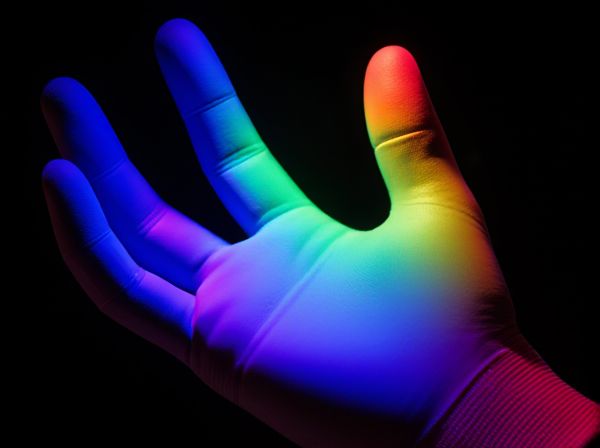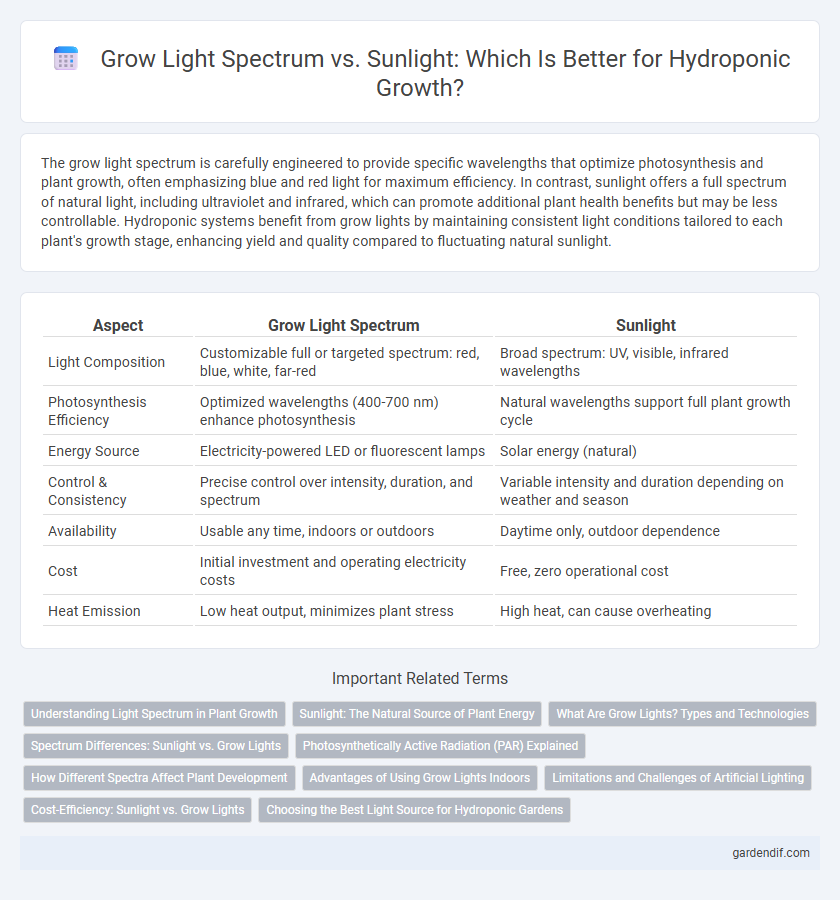
Grow Light Spectrum vs Sunlight Illustration
The grow light spectrum is carefully engineered to provide specific wavelengths that optimize photosynthesis and plant growth, often emphasizing blue and red light for maximum efficiency. In contrast, sunlight offers a full spectrum of natural light, including ultraviolet and infrared, which can promote additional plant health benefits but may be less controllable. Hydroponic systems benefit from grow lights by maintaining consistent light conditions tailored to each plant's growth stage, enhancing yield and quality compared to fluctuating natural sunlight.
Table of Comparison
| Aspect | Grow Light Spectrum | Sunlight |
|---|---|---|
| Light Composition | Customizable full or targeted spectrum: red, blue, white, far-red | Broad spectrum: UV, visible, infrared wavelengths |
| Photosynthesis Efficiency | Optimized wavelengths (400-700 nm) enhance photosynthesis | Natural wavelengths support full plant growth cycle |
| Energy Source | Electricity-powered LED or fluorescent lamps | Solar energy (natural) |
| Control & Consistency | Precise control over intensity, duration, and spectrum | Variable intensity and duration depending on weather and season |
| Availability | Usable any time, indoors or outdoors | Daytime only, outdoor dependence |
| Cost | Initial investment and operating electricity costs | Free, zero operational cost |
| Heat Emission | Low heat output, minimizes plant stress | High heat, can cause overheating |
Understanding Light Spectrum in Plant Growth
The grow light spectrum is meticulously engineered to mimic and enhance sunlight by delivering specific wavelengths of light essential for photosynthesis, such as blue (400-500 nm) and red (600-700 nm) light, which regulate vegetative growth and flowering stages in plants. Unlike natural sunlight, which contains a broad spectrum including ultraviolet (UV) and infrared (IR) rays, grow lights can optimize spectral output to maximize energy efficiency and promote targeted growth responses in hydroponic systems. Understanding the light spectrum helps optimize plant growth by enabling growers to select grow lights that provide ideal wavelengths, improving chlorophyll production, nutrient uptake, and overall yield.
Sunlight: The Natural Source of Plant Energy
Sunlight provides a full spectrum of light wavelengths essential for photosynthesis, including ultraviolet, visible, and infrared rays that promote optimal plant growth and development. This natural source supplies variable intensity and duration, replicating seasonal changes that influence plant cycles and nutrient synthesis. Unlike artificial grow lights, sunlight offers a dynamic and cost-free energy input crucial for hydroponic systems relying on natural processes.
What Are Grow Lights? Types and Technologies
Grow lights are artificial light sources designed to stimulate plant growth by emitting specific light spectra tailored to photosynthesis needs, differing significantly from natural sunlight that provides a broad spectrum. Common types include fluorescent, LED, high-pressure sodium (HPS), and metal halide lamps, each offering unique spectral outputs and energy efficiencies suited for various hydroponic applications. Advanced LED grow lights enable precise control over light wavelengths, optimizing photosynthetic response and growth cycles in controlled indoor hydroponic systems.
Spectrum Differences: Sunlight vs. Grow Lights
Sunlight provides a full spectrum of wavelengths essential for plant growth, including ultraviolet (UV), visible, and infrared light, which collectively promote photosynthesis and natural development. Grow lights typically emit targeted portions of the light spectrum, such as blue (400-500 nm) and red (600-700 nm) wavelengths, optimized to enhance photosynthetic efficiency and flowering in hydroponic systems. Unlike sunlight, many grow lights lack the complete spectral range, often requiring specific combinations or technologies like full-spectrum LEDs to mimic natural sunlight effectively.
Photosynthetically Active Radiation (PAR) Explained
Grow light spectrum and sunlight differ in their Photosynthetically Active Radiation (PAR) output, which ranges from 400 to 700 nanometers and is crucial for plant photosynthesis. Sunlight provides a full PAR spectrum, encompassing blue, red, and green wavelengths essential for various growth stages, while grow lights can be tailored to emit specific PAR ranges optimized for vegetative growth or flowering. Understanding the PAR distribution in hydroponic grow lights helps maximize photosynthetic efficiency and crop yield by closely mimicking or enhancing natural sunlight conditions.
How Different Spectra Affect Plant Development
Different grow light spectra significantly influence plant development by targeting specific photoreceptors that regulate processes such as photosynthesis, flowering, and leaf expansion. Blue light (400-500 nm) promotes vegetative growth and strong root systems, while red light (600-700 nm) enhances flowering and fruit production. Full-spectrum grow lights that mimic sunlight provide a balanced wavelength array, optimizing overall plant health and growth rates in hydroponic systems.
Advantages of Using Grow Lights Indoors
Grow lights offer a precise spectrum tailored to plant photosynthesis, enhancing growth rates and yield compared to natural sunlight indoors. These lights provide consistent illumination regardless of weather conditions or seasonal changes, ensuring optimal photosynthetic activity. Controlled spectral output minimizes energy waste and maximizes nutrient absorption efficiency in hydroponic systems.
Limitations and Challenges of Artificial Lighting
Artificial grow light spectrum often lacks the full range of wavelengths found in natural sunlight, limiting photosynthetic efficiency and plant growth potential. The intensity and penetration of artificial lighting are usually lower, which can restrict canopy coverage and affect vertical growth in dense crops. Energy consumption and heat output from grow lights present additional operational challenges, increasing costs and necessitating advanced cooling systems to maintain optimal growing environments.
Cost-Efficiency: Sunlight vs. Grow Lights
Sunlight provides a full spectrum of light essential for photosynthesis at no cost, making it the most cost-efficient option for hydroponic growers in outdoor setups. Grow lights, while allowing precise control over light spectrum and duration, incur higher energy costs but enable year-round cultivation and optimized plant growth indoors. Evaluating the balance between initial investment, ongoing electricity expenses, and crop yield is critical for determining cost-efficiency between sunlight and artificial grow light spectra in hydroponic systems.
Choosing the Best Light Source for Hydroponic Gardens
Selecting the optimal grow light spectrum is crucial for hydroponic gardens to maximize plant growth and yield. LED grow lights tailored to emit specific wavelengths, particularly blue (400-500 nm) and red (600-700 nm) spectra, closely mimic the photosynthetically active radiation found in sunlight, enhancing photosynthesis efficiency. While sunlight provides a full spectrum naturally, controlled spectrum LED lights offer precision and consistent intensity, making them ideal for indoor hydroponic systems.
Grow Light Spectrum vs Sunlight Infographic

 gardendif.com
gardendif.com